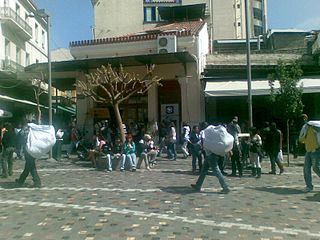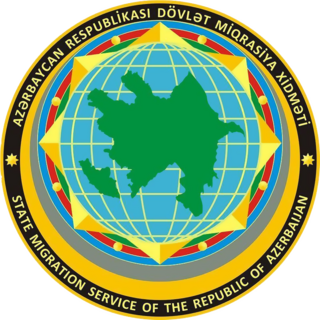Illegal immigration is the migration of people into a country in violation of that country's immigration laws, or the continuous residence in a country without the legal right to. Illegal immigration tends to be financially upward, from poorer to richer countries. Illegal residence in another country creates the risk of detention, deportation, and/or other persecutions.
Immigration to South Korea is low due to restrictive immigration policies resulting from strong opposition to immigrants from the general Korean public. However, in recent years with the loosening of the law, influx of immigrants into South Korea has been on the rise, with foreign residents accounting for 4.9% of the total population in 2019. Between 1990 and 2020, South Korea's migrant population has grown 3.896%, second highest level of growth in the world.

Immigration to Greece percentage of foreign populations in Greece is 7.1% in proportion to the total population of the country. Moreover, between 9 and 11% of the registered Greek labor force of 4.4 million are foreigners. Migrants additionally make up 25% of wage and salary earners.

Immigration to Peru involves the movement of immigrants to Peru from another country. Peru is a multiethnic nation formed by the combination of different groups over five centuries. Amerindians inhabited Peruvian territory for several millennia before Spanish Conquest in the 16th century. Spaniards and Africans arrived in large numbers under the Viceroyalty. Many people from European backgrounds mixed with the Amerindians or Asians creating an entirely new demographic group called "mestizos".

South Africa experiences a relatively high influx of immigration annually. As of 2019, the number of immigrants entering the country continues to increase, the majority of whom are working residents and hold great influence over the continued presence of several sectors throughout South Africa. The demographic background of these migrant groups is very diverse, with many of the countries of origin belonging to nations throughout sub-saharan Africa. A portion of them have qualified as refugees since the 1990s.
Immigration to the People's Republic of China is the international movement of non-Chinese nationals in order to reside permanently in the country.

Visa requirements for Chinese citizens are administrative entry restrictions imposed on citizens of China residing in the Mainland by the authorities of other states.

Visa requirements for Mexican citizens are administrative entry restrictions by the authorities of other states placed on citizens of Mexico

Visa requirements for Australian passport holders are administrative entry restrictions by the authorities of other states placed on citizens of Australia entering with an Australian passport.
Visa requirements for Costa Rican citizens are administrative entry restrictions by the authorities of other states placed on citizens of Costa Rica.

As of 2024, Hong Kong Special Administrative Region passport holders have visa-free or visa on arrival access to 170 countries and territories, ranking the passport 18th in the world according to the Henley Passport Index.It is ranked 16th by the Global Passport Power Rank.
Visa requirements for New Zealand citizens are administrative entry restrictions by the authorities of other states placed on citizens of New Zealand.

The State Migration Service of Azerbaijan Republic is a governmental agency within the Cabinet of Azerbaijan in charge of regulation of activities the sphere of migration taking in consideration issues of national security and stable social-economic and demographic development in Azerbaijan Republic. The committee is headed by Vusal Huseynov.
Azerbaijan though not a popular destination for immigrants, has recently experienced waves of immigration with the collapse of the Soviet Union, especially from ethnic Azerbaijanis mostly from Armenia, Russia and the rest of the former Soviet Union. Meskhetian Turks were also relocated to Azerbaijan from Central Asia before and after the end of the Soviet Union. With the booming petroleum industry, immigration from Turkey has also followed. In 2010, every eighth resident in Azerbaijan was a migrant, of whom more than 90% of them are Azerbaijanis and 70% are internally displaced persons from the territories occupied by Armenia.

Visitors to Thailand must obtain a visa from one of the Thai diplomatic missions unless they are citizens of one of the visa-exempt countries, or citizens who may obtain a visa on arrival, or citizens eligible for an e-Visa.

Visitors to Vietnam must obtain either an e-Visa or a visa in advance, unless they are citizens of one of the visa-exempt countries.
Illegal immigration to China is the process of migrating into China in violation of Chinese immigration laws. The Chinese government has instituted policies against illegal immigration, particularly from North Korean refugees and defectors, workers and refugees from Vietnam, the Philippines, Myanmar, Laos and Africans in Guangzhou.
Since 1991, Korea has experienced a large influx of foreign workers, and the government has utilized trainee programs since 1992. About 10,000 Asian workers came to Korea under this program in 1992, and there were about 57,000 trainees in Korea in June 1996. However, the trainee program experienced problems: the trainees became undocumented workers due to a difference in wages and since they were not classified as laborers, they were not protected by the Labor Standard Law. The Employment Permit Program for foreigners is a product achieved by a decade of interaction between Korean citizens and foreign migrant workers. However, these issues have more details to be resolved. On the legal front, the Korean state still allows foreigners to apply for low-wage jobs and excludes them from social benefits. The social dimension of nationhood is shown by public-opinion polls of Korean citizens' attitudes towards foreign workers, which demonstrate discrimination.

According to the Japanese Ministry of Justice, the number of foreign residents in Japan has steadily increased in the post Second World War period, and the number of foreign residents was more than 2.76 million at the end of 2022. Being a country with a total estimated population of 125.57 million in 2020, the resident foreign population in Japan amounts to approximately 2.29% of the total population.
Immigration to Russia involves foreign citizens seeking permanent residence in the territory of the Russian Federation. Historically, Russian empire was one of the World's leading destination for immigrants starting with the reign of Peter I in ca. 1700, and especially after the ascension of Catherine II to the Russian throne in 1762, until the October Revolution in 1917. Some regions, such as Novorossiya, Slavo-Serbia, Volga Germans' territory and Bessarabia were specifically designated for resettlement of immigrants.












